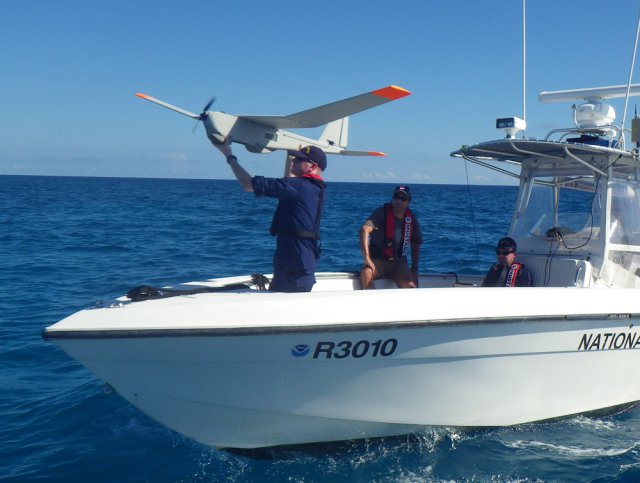NOAA will test whether an unmanned aircraft system (UAS) can help scientists at Florida Keys National Marine Sanctuary observe and monitor wildlife at close range with minimal disturbance, locate marine debris and better understand how boaters use the sanctuary.Test flights of the Puma UAS are scheduled Sept. 14 – 22 in sanctuary waters of the upper and lower Florida Keys. During the mission, NOAA will test the Puma’s feasibility in surveying protected marine life, including roseate spoonbills, roosting frigate birds, sea turtles and Key deer. The Puma can fly lower and slower than manned aircraft and its quiet operating system allows scientists to gather species population data without disturbing wildlife.
Earlier this year, NOAA performed test flights of the Puma UAS at Olympic Coast National Marine Sanctuary in Washington state to explore its feasibility in monitoring seabird colonies along the coastline and offshore islands. Previous UAS tests have also taken place at national marine sanctuaries in California, Hawaii and Georgia
The Puma UAS is launched by hand, either from land or a boat, and controlled remotely by a pilot. It can fly for up to two hours on a single charge and cover a range of about 50 square miles.
Test flights of the Puma UAS are scheduled Sept. 14 – 22 in sanctuary waters of the upper and lower Florida Keys. During the mission, NOAA will test the Puma’s feasibility in surveying protected marine life, including roseate spoonbills, roosting frigate birds, sea turtles and Key deer. The Puma can fly lower and slower than manned aircraft and its quiet operating system allows scientists to gather species population data without disturbing wildlife.
“Testing unmanned aircraft in the diverse habitats of the Keys will help demonstrate the applicability of this technology in supporting science and resource protection in ecosystems around the world,” said Sean Morton, sanctuary superintendent.
The Puma UAS will survey for abandoned and derelict vessels, as well as collect information on marine debris before and after the Sept. 21 International Coastal Cleanup, a global volunteer effort to clean up waterways and the ocean. Mission objectives also include assessing boater use of heavily trafficked areas in both the upper and lower Keys.
The Puma is a 13-pound, battery-powered aircraft with a nine-foot wingspan, equipped with real-time video and photo capability. The aircraft can be hand-launched and recovered from any location on land or at sea from a boat. Durable and rugged for deployment to remote marine areas and repeat usage, the aircraft can fly for up to two hours on a single charge and cover a range of about 50 square miles.
“Unmanned aircraft systems represent the next development in marine resource monitoring, and are potentially cheaper, greener and safer than manned flights,” said Matt Pickett, aviation operations coordinator for NOAA’s Office of National Marine Sanctuaries.
During the test, the aircraft will be launched either from a sanctuary vessel or the shoreline and recovered from the water. The Puma will be controlled remotely by a NOAA Corps pilot with the NOAA Office of Marine and Aviation Operations. Funded by NOAA’s Unmanned Aircraft System Program, the test missions will demonstrate the aircraft’s camera resolution and allow scientists and managers to explore the aircraft’s potential to support management of sanctuaries, wildlife refuges and national parks.
NOAA is partnering to test the UAS with scientists and resource managers from the U.S. Fish and Wildlife Service, National Park Service and U.S. Coast Guard. The sanctuary is providing support to this year’s mission through vessel use and staff time.
If test missions are successful, unmanned aircraft technology could be used in marine protected areas worldwide. Previous UAS tests have taken place at national marine sanctuaries in Washington state, California, Hawaii and Georgia.
Florida Keys National Marine Sanctuary protects 2,900 square nautical miles of critical marine habitat, including coral reef, hard bottom, sea grass meadows, mangrove communities and sand flats, as well as shipwrecks and maritime heritage resources. NOAA and the state of Florida manage the sanctuary.
Source: NOAA

